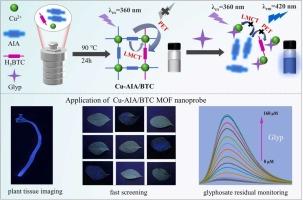用于植物组织成像、快速筛选和灵敏检测环境样品中草甘膦的低背景双配体 Cu-MOF 纳米探针
IF 12.2
1区 环境科学与生态学
Q1 ENGINEERING, ENVIRONMENTAL
引用次数: 0
摘要
由于草甘膦具有很高的环境风险,因此监测环境样本中的草甘膦残留量至关重要。在此,我们报道了一种低背景双配体、快速响应的铜基金属有机框架(Cu-MOF)纳米探针,用于植物组织中草甘膦的成像、草甘膦污染样品的快速筛查以及环境样品中草甘膦的灵敏检测。Cu-MOF 纳米探针以 2-Aminoisophthalic Acid (AIA) 和 trimesic acid (H3BTC) 为配体,以 Cu2+ 为金属节点制备而成。由于配体对金属的电荷转移(LMCT)和光诱导电子转移(PET)效应,配体 AIA 的荧光可以在 Cu-AIA/BTC 探针中被完全淬灭。加入草甘膦后,草甘膦与 Cu-AIA/BTC 探针中的配体发生竞争,导致 MOF 结构崩溃,配体 AIA 释放,荧光明显恢复。该纳米探针在 0.1-80 μM 浓度范围内对草甘膦具有理想的线性响应,检测限低至 33 nM,远低于美国环境保护局(EPA)规定的最大污染物含量(4.1 μM)。此外,该纳米探针还成功应用于植物组织成像、草甘膦污染样品的快速筛查以及茶叶和土壤中草甘膦降解的监测,表明该纳米探针具有广阔的应用前景。本文章由计算机程序翻译,如有差异,请以英文原文为准。

Low background dual-ligand Cu-MOF nanoprobe for plant tissue imaging and fast screening as well as sensitive detection of glyphosate in environmental samples
The monitoring of glyphosate residue in environmental samples is critically important due to its high environmental risk. Here, we reported a low background dual-ligand and fast response copper-based metal organic framework (Cu-MOF) nanoprobe for imaging glyphosate in plant tissue, rapid screening of glyphosate-contaminated samples, and sensitive detection of glyphosate in environmental samples. The Cu-MOF nanoprobe was prepared with 2-Aminoisophthalic Acid (AIA) and trimesic acid (H3BTC) as ligands, and Cu2+ as a metal node. Thanking to both ligand-to-metal charge transfer (LMCT) and photoinduced electron transfer (PET) effects, the fluorescence of ligand AIA could be fully quenched in Cu-AIA/BTC probe. Upon the addition of glyphosate, it competed with the ligands in Cu-AIA/BTC probe, causing the collapse of MOF structure and the release of ligand AIA with obvious fluorescence recovery. This nanoprobe exhibited a desirable linear response for glyphosate in the concentration range of 0.1–80 μM, with a low detection limit of 33 nM, much lower than the maximum contaminant level (4.1 μM) set by the U.S. Environmental Protection Agency (EPA). Furthermore, it was also successfully applied for plant tissue imaging, fast screening of glyphosate-contaminated samples and monitoring of the degradation of glyphosate on tea leaves and in soil, indicating the broad application prospect of the nanoprobe.
求助全文
通过发布文献求助,成功后即可免费获取论文全文。
去求助
来源期刊

Journal of Hazardous Materials
工程技术-工程:环境
CiteScore
25.40
自引率
5.90%
发文量
3059
审稿时长
58 days
期刊介绍:
The Journal of Hazardous Materials serves as a global platform for promoting cutting-edge research in the field of Environmental Science and Engineering. Our publication features a wide range of articles, including full-length research papers, review articles, and perspectives, with the aim of enhancing our understanding of the dangers and risks associated with various materials concerning public health and the environment. It is important to note that the term "environmental contaminants" refers specifically to substances that pose hazardous effects through contamination, while excluding those that do not have such impacts on the environment or human health. Moreover, we emphasize the distinction between wastes and hazardous materials in order to provide further clarity on the scope of the journal. We have a keen interest in exploring specific compounds and microbial agents that have adverse effects on the environment.
 求助内容:
求助内容: 应助结果提醒方式:
应助结果提醒方式:


